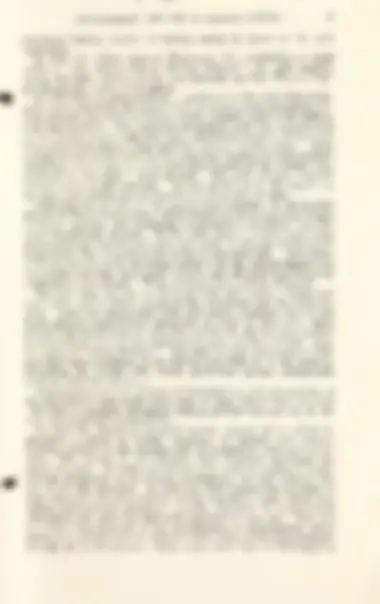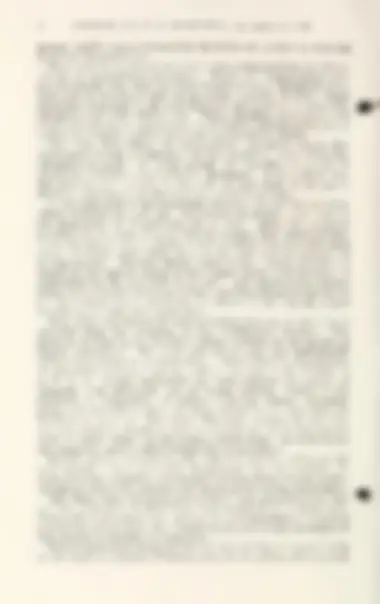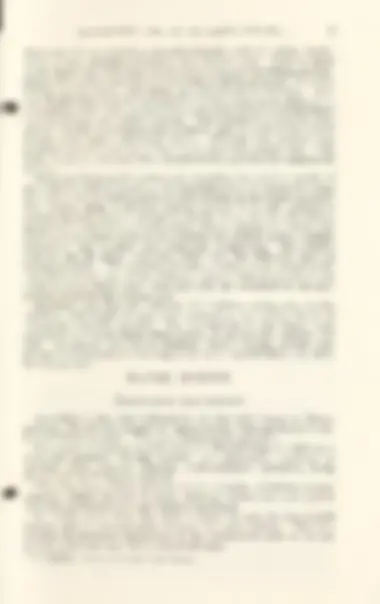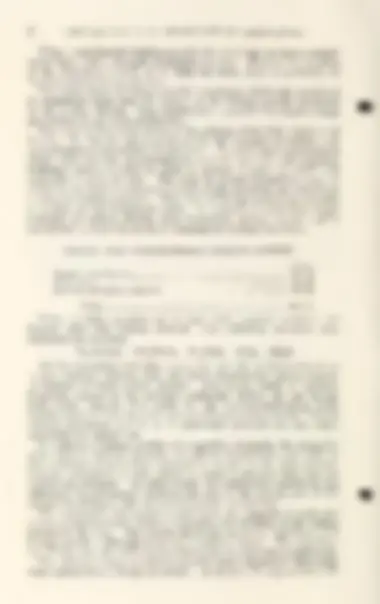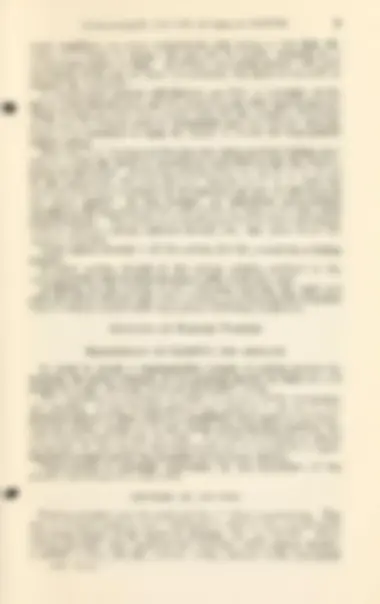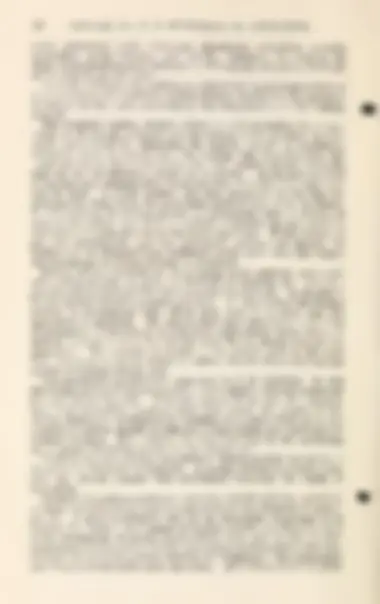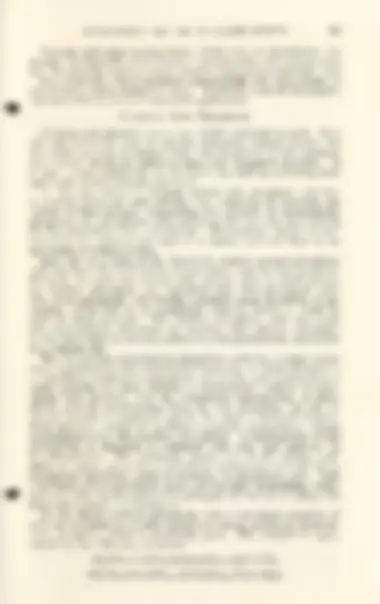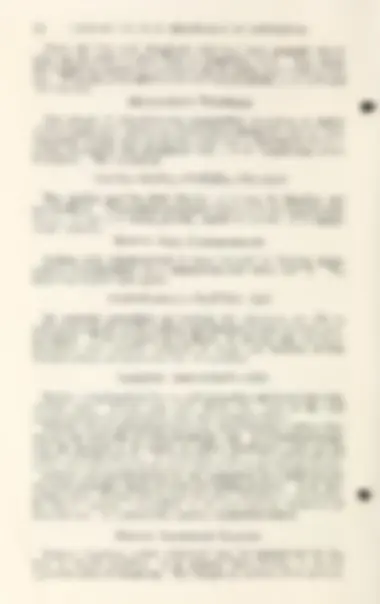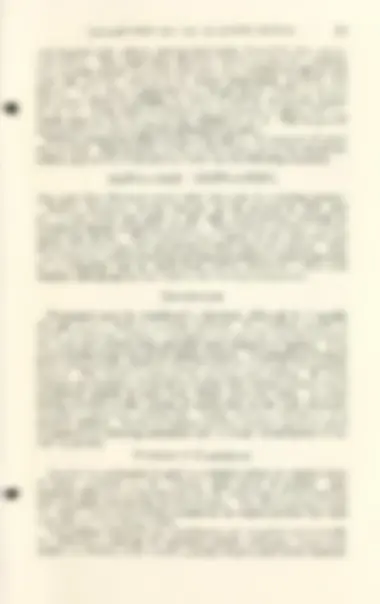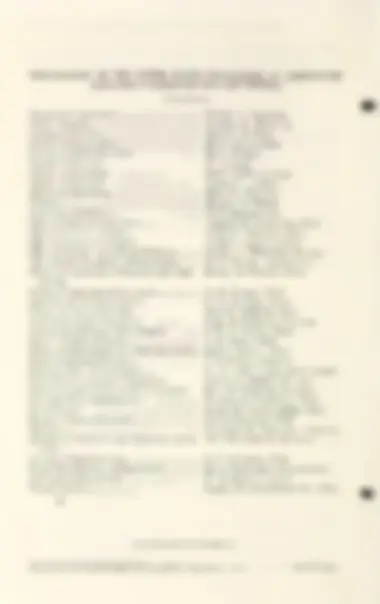Download Development and Use of Baking Powder and Baking Chemicals and more Study Guides, Projects, Research Chemistry in PDF only on Docsity!
Circular No. 138
? R /\ R Y
;eE!VED
;cuiure
Issued November^1930 Revised^ May^ ^^^^
Washington, D. C. ||l
UNITED STATES DEPARTMENT OF AGRICULTURE
Development and Use of Baking Powder
and Baking Chemicals
ByL. H. Bailey, ''I associate chemist, Food Research Division, Bureau^ of Agricultural
Chemistry and^ Engineering
CONTENTS
Page Introduction History of leavening (^11) Baking Production powder (^) and export 55 Definition Purity and standard (^66) Classification Chemical composition 6 The^ Analysis production^ of^ baking of baking^ powder chemicals^119 Bicarbona^ of soda,. 11
Page The (^) Creamproduction of tartar of baking chemicals— Contd. 11 Tartaric Calcium acidacid (^) phosphate (^1213) Monosodium Sodium acid pyrophosphatephosphate (^1414) Sodium Cornstarch aluminum sulfate (^1415) Literature^ Ammonium cited.^ carbonate^1516
INTRODUCTION
Baked products become light, as a rule, by the expansion of the
carbon dioxide which is evolved within the dough or batter during its
preparation and in the early stages of baking. The carbon dioxide may be produced by yeast, baking powder, or baking chemicals.
Yeast is used in making bread, rolls, and certain types of biscuits and
crackers, whereas baking powder and baking chemicals are used in
most other baked products. Considerable time is required for the
production of the carbon dioxide by yeast, but with baking powder a
part of the gas is liberated as soon as the liquid is added and the
remainder when heat is applied (^) as in (^) baking.
HISTORY OF LEAVENING
Leavening was practiced by the Eygptians, and the practice was
handed down by them to the Greeks and by the Greeks to (^) the Romans I (^) Italic numbers in (^) parentheses refer to Literature Cited, p. 16. 186669°— (^40 )
2 CIRCULAR 13 8, U. S. DEPARTMENT OF AGRICULTURE
From the time of the Romans to the present, the use of leavening
has been common. In the early days leavening was ordinarily ac-
complished by gro^\dng yeast or yeasts in a dough or batter rich in
carbohydrates. The enzymes of the yeast act upon the carbohy-
drates, forming carbon dioxide and alcohol. The carbon dioxide gas permeates the dough and intermingles with it; when heat is
applied, as in baking, the gas expands, and produces a porous m.ass.
As the heat continues the framework becomes more solid, and an
open spongelike product results.
One of the early types of leavened bread was kno\Ti as salt-rising
bread. The gas which leavens bread of this type is furnished by
bacteria, such as Bacillus welchii, instead of yeast. Formerly it was
made (^) by allowing (^) a mixture of wheat meal, corn (^) meal, salt, and hot milk to stand in a warm place for several hours, (^) when gas was pro- duced and the mass became porous. Flour was added to make (^) a
dough, and it was then allowed to rise and was baked in the usual
manner.
Such spontaneous fermentation^ lacked uniformity, however, and
the results were very uncertain. Today practically all (^) salt-rising bread is made with a commercial '^salt rising" yeast, which is a culture
of the bacteria that furnish the gas for leavening. With this culture
the results are much more uniform and dependable.
Three-quarters of a century ago there was brought out in England
a method of making^ aerated^ bread^ ^^ithout^ the^ use^ of^ either yeast or
baking powder. This method consisted in mLxing flour with, water
that was charged with carbon dioxide, the mixing being done under
pressure which ranged from 40 to 200 pounds. After it was mixed,
the dough was released into pans. With the removal of the pressure
and with the heat of the oven the carbon dioxide expanded and
produced a leavened loaf. Aerated^ bread^ also^ was^ made to a very
limited extent in France, Germany, and the United States.
Yeast requires considerable time to produce sufficient carbon
dioxide to properly leaven a product. To obviate this delay, it be-
came customary for the housewife to use sour milk and soda to
supply the carbon dioxide necessary to^ leaven^ certain^ of her baked
products. Because all sour milk does not possess the same degree of
acidity, there has always been uncertainty as to how much soda should be used to neutralize the acid. If too much soda is used,
undesirable products result.
Chemical leavening by means of a carbonated^ alkali^ and^ muriatic
acid was proposed as early as the latter part of the eighteenth cen-
tury and has occasionally been suggested in the literature until as
recently as 1916, but this means of leavening has never been generally
employed.
Baking powder was^ the^ natural^ sequel^ to^ the^ early^ methods^ of
leavening. The first formulas for baking powder were developed
in the United States in 1850. In that year a cream of tartar baking
powder was sold by Preston & Alerrill of Boston.
In 1853 Vincent C. Price, of Troy,^ N.^ Y.,^ is^ said^ to^ have^ com-
pounded a baking^ powder^ consisting^ of^ cream^ of^ tartar^ and^ soda,
with starch or flour as a stabilizmg ingredient. The first reference
to baking powder in scientific literature appeared ui the Archiv der
Pharmacie in 1855 (11). The author,^ E.^ Reichardt,^ investigated^ an
4 CIECULAE^13 8,^ U.^ S.^ DEPAKTMEXT^ OF^ AGEICUI.TURE
ground marble was substituted for the bone ash, producing materiaL
of similar characteristics. ISIore recently further improvements have been made in (^) the manu- facture of monocalcium^ phosphate. Nearly all mani;facturers (^) now
use phosphoric^ acid^ that has been volatihzed from phosphate rock.
This acid is practically free of unpurities, notably fluorine, which
sometimes remained in the acid that was produced by treatmg the
phosphate rock ^^dth sulfuric acid. TThen volatihzed phosphoric acid
is treated with the calculated amount of purified calcium hydroxide or
carbonate, a highly^ purified monocalcium phosphate results.
The speed "^^ith^ which^ the monocalcium phosphate reacts with
bicarbonate of soda is influenced by the conditions under which the
phosphate is made. A recent patent (^) {13) describes (^) a process of
producing anhydrous monocalcium phosphate. It is claimed that
this product reacts slowly in the cold, so that most of the gas is
hberated after heat is apphed durmg the baking process.
In the early part of the nineteenth century alum and the potashes,
which included pearlash and bicarbonate of potash, were used in
the preparation of gmgerbread {16, p. 181). After the successful
introduction of cream of tartar baking powder other manufacturers,
in an attempt to find a substitute that would be less expensive than
cream of tartar,^ used^ burnt^ alum^ as^ the^ acid-reacting material in
baking powder. The first official notice of alum (^) baldng powder ap-
peared in the annual report of the United States Commissioner of
Agriculture for the year 1878 (-5, p. 135). The report of the chemist
states that a sample of baking powder had been submitted for analy-
sis, the composition of which was as follows: 3 parts starch, 1 part
bicarbonate of^ soda,^ and^1 part^ aliun.
That alum was frequently used in baking powders at this time is
apparent from the comment of the Government chemist: ''The
presence of alum in the so-called baking powders on the market is
ahnost invariable." The alum referred to here was undoubtedly either burnt potash^ or^ ammonia^ alum.^ About 1892 the manufacture of anhydrous sodium alummum sidfate, now frequently (^) referred to
as S. A. S., became established and soon replaced the potash or
anmionia alum previously used in baking powder. Owing to the
similarity m composition of sodium aluminum sulfate, potassium alum, and ammonium alum, the^ first named has^ at times been re-
ferred to^ as^ an^ alum.^ One^ State,^ Wisconsin,^ requires^ by law^ that
any compoimd of alummum used as a constituent of baking powder
shall be called ''alum" on the baking powder label. In other States
the compound used is called sodium aluminum sulfate.
Baking powders containing only sodium aluminum sulfate as the
acid ingredient have practically disappeared from the market. In
their stead have appeared combination powders which contam sodium
aluminum sulfate and calcium acid phosphate in varymg proportions.
Still other types of bakmg powder have been proposed from tune
to time, and some of them have^ been^ marketed^ on^ a large^ scale,
^lonosodium phosphate was used as the acid ingredient of a bakmg
powder for several years, but. largely on account of the mstabiHty of
this powder, it was finally abandoned.
Patents have been issued for the use of^ a^ number^ of^ organic^ acids
as the acid constituents of baldng powder, or baking acids; among
DEVELOPMENT AND USE OF^ BAKING^ POWDER^5 these may be mentioned acetonedicarboxylic^ acid^ {1), adipic,^ lactic, malic, mucic, phthalic-anhydride,^ and^ succinic^ acid.^ None^ of^ these
acidic factors^ has^ had^ large^ commercial^ acceptance^ in^ baking^ powder.
Either tlieir acid properties are too weak or^ the^ keeping^ quality^ of^ the
halving powder made with^ them^ has^ not^ proved^ satisfactory.^ Ace-
tonedicarboxylic acid^ was^ proposed^ as^ a^ leavening^ agent^ alone,^ i.^ e.,
uncombined with soda, as upon the application of^ heat^ it^ would^ break
up into acetone and carbon dioxide.^ The^ acetone^ is^ said^ to^ be^ com-
pletely volatilized at^ baking^ temperatures,^ and^ no^ solid^ residue^ would
remain with such a leavening agent. Although this product was
proposed several 3^ears ago it has never come into^ general^ use. Cal-
cium lactate is now used^ with^ phosphates^ in^ a^ powder^ for^ commercial bakers. There has been much controversy regarding the relative merits of
the different baking powders, the^ principal^ point^ of^ discussion^ being
the residue of the baking^ powder^ that^ remains^ in^ the^ baked^ product.
The residue^ from^ a^ tartrate^ baking^ powder^ is^ largely^ potassium
sodium tartrate; from a phosphate powder it is calcium and sodium
phosphates; and from a combination^ sodium^ aluminum^ sulfate^ cal-
cium acid phosphate^ powder^ the^ residues^ are^ sodium^ sulfate,^ sodium
phosphate, and calcium and aluminum compounds. The soluble
residues are all saline, and they differ with the different types of
baking powders. The quantity of saline residues in the baked prod-
ucts leavened by any^ of^ the^ ordinary^ types^ of^ baking^ powder^ is^ too
small to be injurious^ when^ these^ products^ are^ consumed^ in^ the^ pro-
portion found in the average diet.
Questions regarding the influence of aluminum compounds on the
nutrition and health of man were referred to the referee board of consulting scientific^ experts.^ The^ conclusions^ of^ this^ board^ v^ere
published in United States Department of Agriculture Bulletin 103
(12). In^ general,^ the^ board^ concluded^ that^ a^ baking^ powder^ con-
taining a compound of aluminum is no more harmful than any other
baking powder.
BAKING POWDER Production and Export According to the data collected in the Biennial Census of Manu-
factures, 141,707,536 pounds of baking powder were produced in the
United States in^ 1937. This^ was valued at $15,400,497.
The exports of baking powder from the United States in 1938 were
2,731,162 pounds.^^ Baking^ powder^ was^ principally^ exported^ to
Sweden, Cuba, Mexico, Panama, Newfoundland, Labrador, Hong
Kong, and the Philippine Islands.
There has been a large decrease in the quantity of baking powder
exported during the last 10 years, although during the same period
domestic production has only slightly decreased.
In recent years there has been a large increase in commercial
baking with a corresponding decrease in home baking. This (^) has
resulted in increased production of the commercial type of baking
powder and a decrease of the household type.
2 Data furnished by the U. S. Department (^) of Commerce.
DEVELOPMENT AND^ USE^ OF^ BAKING^ POWDER^7 bicarbonate of soda:^ Cream^ of^ tartar,^44 pounds;^ tartaric^ acid,^116
pounds; monocalcium^ phosphate,^80 pounds;^ sodium^ aluminum^ sul-
fate, 104 pounds;^ sodium^ acid^ pyrophosphate,^75 pounds.
These theoretical values are^ seldom^ used^ in^ the^ commercial^ manu-
facture of baking powders.^ The^ manufacturers^ of^ baking^ powder
chemicals are^ in^ a^ position^ to^ furnish^ formulas^ that^ will^ give^ optimum
baking results with their materials.^ Practical^ formulas^ should^ be
obtained from the manufacturers.
CREAM OF TARTAR^ AND^ TARTARIC^ ACID^ BAKING^ POWDER Percent
Sodium bicarbonate 26. 73
Cornstarch 22. 40 Tartaric acid 5. 97 Potassium bitartrate (cream^ of^ tartar)^ 44.^90 Total 100. 00
In the presence of moisture, a reaction occurs between the compo-
nents of the baking powder, and carbon dioxide is liberated; in addi-
tion there are certain byproducts of reaction^ which^ for^ the most part
remain as^ residues^ in^ the^ baked^ products.^ In^ the^ baking^ powder
cited the^ residues^ are^ potassium^ sodium^ tartrate^ and^ sodium^ tartrate.
The probable reactions may be indicated by the following equations: KH C4H4O6 + NaH CO3 = KNaC4H406 (^) + CO2 (^) + H2O
and
H2C4H406 (^) + 2NaHC03 =^ Na2C4H406 (^) + 2C02 (^) + 2H20. CALCIUM ACID PHOSPHATE BAKING POWDER
Sodium bicarbonate Percent26. 73
Cornstarch 39. 84 Calcium acid phosphate 33. 43 Total (^) 100. 00
With phosphate baking powders the reactions are somewhat com-
plicated, varying under different conditions. Three equations follow
which represent reactions that may take place under favorable con-
ditions. The third equation represents what probably takes place
under conditions of baking.
2CaH4(P04)2 3CaH4(P04)2+4NaHC03 (^) + 4NaHC03 == 2CaHP04Ca3(P04)2 (^) + 2Na2HP04 (^) + 4C02 (^) + 4H20 (^) (1) 3CaH4(P04)2 +^ 4NaH2P04^ +^ 4C02^ +^ 4H20^ (2)
- 8NaHC03^ =^ Ca3(P04)2^ + 4Na2HP04^ + 8C02 + 8H20 (^) (3)
The first equation indicates a residue of dicalcium phosphate and
disodium phosphate. The other two indicate the formation of tri-
calcium phosphate and monosodium or disodium phosphate.
COMBINATION BAKING POWDER (S. A. S. PHOSPHATE) Percent Percent
Sodium bicarbonate 26. 73 26. 73
Cornstarch 40. (^) 07] [42. 97
Monocalcium Sodium aluminum phosphate 13. 28 > or < 4. 62
sulfate (calcined) 19. 92] [25. 68 Total 100. (^00) 100. 00
8 CIRCULAR^13 8, U. S. DEPARTMENT OE AGRICULTURE
With a combination baking powder the reactions are more compli-
cated than with a straight phosphate powder. Besides the reaction
of the phosphate and S. A. S. with the soda, there is probably an
interreaction between the two.
The three types of baking powder mentioned above are (^) estimated
to constitute more than 90 percent of the baking powder produced
in the United States. The combination (^) powders represent a large
proportion of the total production.
One type of leavening seems to be gaining favor with (^) commercial
bakers. In this the gas is produced by the reaction of sodium acid
pyrophosphate and sodium bicarbonate. In most cases cornstarch is
mixed with the acid pyrophosphate, and the two are sold together.
Sufficient starch is used to make a product (^2) parts of which will neutralize 1 part of soda. The soda in proper proportion (^) may be
added to the acid pyrophosphate and starch, however, and thus form
a complete baking powder. This kind of baking powder is not sold,
as a^ rule,^ to^ the^ household^ trade.^ It contains a somewhat larger
quantity of carbon dioxide than household baking pow^der and is
calculated to meet the needs of commercial baking conditions.
SODIUM ACID PYROPHOSPHATE BAKING POWDER
There is some question as to just what reaction products are
formed with this baking powder. The following equation (^) may
represent the reaction:
All the foregoing formulas except the last are so proportioned as
to give baking powders that will yield theoretically approximately
14 percent of total carbon dioxide. The fourth yields 17 percent.
Fourteen percent is the strength ordinarily desired for the house-
hold trade, whereas that made for the commercial-baking trade usually contains from^16 to 17 percent of total carbon dioxide. Mono- calcium phosphate and S. A. S. phosphate powders are also made especially for bakers' use.
In making a baking powder of a specified strength, the manufac-
turer takes a definite quantity of sodium bicarbonate^ and^ adds^ to
this sufficient^ acid-reacting^ material^ to^ neutralize^ the^ soda^ present.
Enough cornstarch is then added to make a product that has the
desired gas strength. In other words, the cornstarch constitutes the
difference, in percentage, between the sum of the percentages of the
sodium bicarbonate and acid-reacting material^ and 100.
The cornstarch also separates and coats the particles of soda and
acid-reacting materials, thereby increasing the stability of the baking
powder in the can. The cornstarch is not an active ingredient^ of a
baking powder, although it serves a useful^ purpose.^ The^ bicarbon-
ate of^ soda^ and^ the^ acid-reacting^ materials^ are^ essential^ constituents.
The different types of baking powder react somewhat differently
when mised into a dough or batter. A tartrate baking powder^ will
Sodium bicarbonate
Cornstarch
Sodium acid pyrophosphate.
Total (^) 100. 00
NasHsPsO: + 2 NaHCOa = Na4P207 + 2CO2 (^) + 2H2O
10 CIRCULAR^13 8, U. S. DEPARTMEXT (^) OE AGRICULTURE
oxide, potassium oxide, ammonia, phosphoric anhydride, tartaric
anhydride, sulfur trioxide, and starch. Methods for making all
these determinations mav (^) be found in Official and (^) Tentative Methods
of Analysis {2, pp. 184-190).
As a rule, however, the routine analysis of baking powders is limited
to determining the available carbon dioxide, testing for the presence
of heavy metals, and ascertaining the components of the baking
powder.
The available carbon dioxide, which is evolved during the prepa-
ration of the dough or batter and the baking of the product, is ordi-
narily determined by subjecting the baking powder to conditions
imitating those of actual use. In making this determination the
usual practice is^ first to^ determine the total carbon dioxide, then the
residual, (^) and by difference obtain the available. An indirect (^) method
of making any determination is undesirable, however, if a direct one
can be u.sed. A direct method has (^) been proposed (^) (4) for this (^) de- termination when using the gasometric method (^) soon to be described.
In this method the baking povrder is decomposed with a solution of
ammonium sulfate and heat is applied to remove the (^) gas, which is
collected and measured under standard conditions. If the volume of
gas, the temperature, and the barometric pressure are known, its
weight can be obtained from published tables, and from this weight
the percentage of carbon dioxide is calculated.
Details of two methods for determining total, residual, and avail-
able carbon dioxide are given in Methods of Analysis (2). One is a
gravimetric method and the other a gasometric method. In the gravi-
metric method Knorr's apparatus is used. In this method the baking
powder is decomposed with dilute acid, heat is appHed, and the
apparatus is aspirated. Th^ gas is dried and collected in a solution
of potassium hydroxide or in soda lime, precautions being taken to
exclude moisture and carbon dioxide from the air dra^n through the
apparatus. The increase in weight^ of the potash bulb or the soda
lime tube^ is^ taken^ as^ the^ weight^ of^ carbon^ dioxide^ liberated from the
sample of baking powder used.
The gasometric method was suggested by J. R. Chittick. In this
the baking powder is decomposed in a flask which is directly connected
to a gas-measuring tube. After^ the^ volume^ of^ the gas, the tempera-
ture, and^ barometric^ pressure^ have^ been^ noted,^ the^ weight^ of the
carbon dioxide is determined by referring to a table which gives the
weights of carbon dioxide at different temperatures and pressures for
various volumes. This method has been modified by the specifying
of 1.7 grams of baking powder^ as^ the^ charge^ (3).
Methods for^ determining^ impurities^ in^ baking^ powder^ are^ given^ in
detail in the Methods of Analysis. A baking powder is a food acces-
sory and should comply with estabUshed standards for limits of
impurities.
^lethods for making^ qualitative^ tests^ for^ tartaric^ acid^ and^ tartrates,
calcium, and phosphoric^ acid^ are^ also^ given^ in^ the^ Methods^ of^ Analy-
sis (^) (2). A good quaHtative test for an alumimmi compound is as follows (^) (7): From 1 to 2 grams of baking powder are^ dissolved^ in 5
cubic centuneters of normal hydrochloric^ acid,^ and^ to^ this^5 cubic
centimeters of three times^ normal^ ammonium^ acetate^ and^5 cubic^ cen- timeters of one-tenth percent solution of "aluminon," the ammonium
salt of aurintricarboxylic acid, are added. After^ being^ mixed^ to^ aUow
DEVELOPMENT AND^ USE^ OF^ BAKING^ POWDER^11 the lake formation^ to^ take^ place,^ the^ solution^ is^ made^ alkaline^ with ammonium hydroxide containing ammonium carbonate. A bright^ red
precipitate which persists in the^ alkaline^ solution^ indicates^ the^ pres-
ence of aluminum.^ This^ method^ has^ been^ modified^ so^ that^ it^ may^ be
used to determine^ aluminum^ quantitatively^ (17, 18).
The kind of starch present may be ascertained^ by the aid^ of the
microscope. Cornstarch is^ ordinarily^ used^ in^ baking^ powders.
Baking powders^ slowly^ deteriorate^ on^ standing,^ more^ rapidly^ if^ the
can is^ frequently^ opened,^ or^ if^ mositure^ gains^ access^ to^ the^ baking
powder, thereby causing some reaction between the acid material and
the bicarbonate. A baking^ powder^ should^ keep^ satisfactorily^ for^ at
least a year^ if^ it^ is^ stored^ under^ proper^ conditions.
A recent patent has been issued (^) (6) describing a method of improv-
ing the keeping quality of baking powder. This method is based on
the principle of like^ charges^ of electricity^ repelling^ each^ other.^ In
this method the^ acid-reacting^ substance^ is^ electrostatically^ treated^ to
give it a charge of like sign as the bicarbonate of soda, i. e., both
must have either positive or negative charges.
THE PRODUCTION OF BAKING CHEMICALS Bicarbonate of Soda
Bicarbonate of soda^ is^ the^ alkaline^ ingredient^ of^ practically^ all
baking powders.^ It^ is^ relatively^ cheap^ and^ is^ one^ of^ the^ purest^ chem-
icals manufactured. In the United States it is all made by the Solvay process. The ammonia-soda or^ Solvay^ process^ utilizes ordinary salt in the
form of^ brine.^ This^ is^ an^ advantage^ in^ countries^ like^ the United
States where salt is found in deep-seated deposits and is extracted by
means of the salt well. The strong brine solution is run into satura- tion tanks, where it comes in contact with ammonia gas. The ammo-
niacal brine^ is^ forced^ under^ pressure^ into^ the^ carbonating tower
through a pipe near the middle of the tower. The carbon (^) dioxide is
forced into the lower end of the tower and allowed to bubble through
many perforated diaphragms. The reaction may be expressed as follows: NaCl +NH3 +H2O (^) +CO2 =NH4C1 +NaHC
The bicarbonate of soda, being insoluble in the ammonium-chloride
solution, is precipitated, drawn off, filtered, washed with cold water,
and dried.
Sodium bicarbonate may also be formed by passing (^) a current of
carbon dioxide and steam over soda ash at a temperature of 80°^ C.
This reaction^ is^ represented^ by the following equation:
NaaCOs +CO2^ +H2O^ =2^ NaHCOg Cream of Tartar Cream of tartar is potassium bitartrate or potassium-hydrogen
tartrate. Its only commercial source is grapes. Tartrates exist in
the grape as potassium bitartrate, calcium tartrate, and in small
quantities as free tartaric acid. Most tartrates are obtained commer-
DEVELOPMENT AND^ USE^ OF^ BAKING^ POWDER^13 Tartaric acid exists in four forms, which may be classified in two
groups: (1) Optically active forms, cl-tartaric acid and 1-tartaric acid,
and (2) optically inactive forms, racemic acid and mesotartaric^ acid.
Only d-tartaric acid is^ produced^ commercially;^ the^ other^ forms^ do
not occur in nature except in traces. Synthetic methods of prepara-
tion have had as yet no commercial application.
Calcium Acid Phosphate
Calcium acid phosphate is a very widely used baking acid. It is
the sole leavening acid of straight phosphate baking powder for
household use and constitutes^ from^5 to 14 percent of the combina-
tion sodium aluminum sulfate-calcium acid phosphate powders. It
is used almost exclusively as the leavening acid in self-rising flour
and is also used in phosphated flours.
At first the process of making calcium acid phosphate consisted
in treating^ bone^ ash^ with^ sulfuric^ acid,^ removing^ by^ filtration^ the
sulfate of lime formed, evaporating the solution of monocalcium
phosphate and phosphoric acid, purifying this solution, neutralizing
the free phosphoric acid, and drying.^ Monocalcium phosphate pro-
duced by this^ process^ was^ used^ as^ a-^ baking^ acid^ and later^ as an
ingredient of baldng powder.
Since the early part of the twentieth century natural phosphate
rock has been the chief source of phosphate used for food purposes.
Formerly the rock was treated with surfuric acid, in which process
the tribasic phosphate was converted into free phosphoric acid.
The crude phosphoric acid usually contained small quantities of im-
purities, which had to be completely removed before it could be
used for food purposes. The purified phosphoric acid was made
into monocalcium^ phosphate^ by reaction^ with calcium^ carbonate.
It was then dried in vacuum, milled to a fine granulation, and bolted
to a uniform size.
The wet process of producing phosphoric acid has to some extent
been supplanted by the volatilization processes, in which phosphorus
is volatilized, oxidized to phosphoric anhydride, and condensed in a
small quantity of water, yielding a concentrated solution of phos-
phoric acid (H3PO4). For the commercial manufacture of phos-
phoric acid by volatilization there are two processes. In one an
electric furnace is employed and in the other a fuel-fired furnace.
Both processes consist in smelting a properly proportioned charge
of phosphate rock, siliceous flux, and carbon. A small portion of the
phosphorus so liberated is combined with iron, and removed as
ferrophosphorus. (^) The remainder passes out of the charge, with
gases, as vapor, and is then oxidized by combustion with the air to
phosphorus pentoxide, which is hydrated to phosphoric acid. This
volatilized acid is practically pure and has high neutralizing value;
however, after its formation it is subsequently treated to reduce the
impurities present to a minimum.
To the highly purified phosphoric acid a calculated quantity of
calcium carbonate or calcium hydrate is added, producing monocal-
cium phosphate which is (^) practically pure. The reaction is repre-
sented by the' following equations:
2H3P04+CaC03=CaH4(P04)2.H20-|-C
2H3P04+Ca(OH)2=CaH4(P04)2.H20+H
14 CIRCULAR (^13) 8, U. S. DEPARTMENT (^) OF AGRICULTURE When the lime and phosphoric (^) acid have been properly (^) mixed,
they are set aside to allow them to completely react. After aging,
the product is crushed (^) to a medium size to insure (^) more uniform dry- mg. When dry, it is (^) milled to the desired granulation, (^) and packaged
for shipment.
MoNOsoDiuM Phosphate The (^) process of manufacturing monosodium (^) phosphate is similar
to that employed in producing monocalcium phosphate; that is, some
compound of soda, such as sodium carbonate, is thoroughly mixed in
proper proportion with phosphoric acid to form monosodium ortho-
phosphate. The reaction is: Na.COs +^ 2H3PO4 = 2NaH2P04 + CO2 (^) + H2O The product may be dried directly, (^) or it may be dissolved (^) and recrystallized. Monosodium phosphate, (^) however, is not entirely satis-
factory for use in a baking powder, largely on account of its hygro-
scopic property.
Sodium Acid Pyrophosphate
Sodium acid pyrophosphate is manufactured by heating mono-
sodium orthophosphate to a temperature well below 250° C. The
following reaction takes place:
2NaH2P04 (^) + heat = NazHsPsO: + H2O By carefully controlling the heating, manufacturers (^) are able to
convert practically all the sodium orthophosphate into the acid pyro-
phosphate. If the temperature is allowed to rise too high, the pyro-
phosphate loses another molecule of water and becomes sodium
metaphosphate, as represented by the equation:
NasHsPsO: +heat^ =^ 2NaP03^ +^ H2O
Sodium metaphosphate has no acid properties and is of little com-
mercial value.^ Kecent^ tests^ have^ shown^ that most of the acid
pyrophosphates are practically free from metaphosphate.
Sodium acid pyrophosphate has much better keeping qualities than
the sodium acid salts of orthophosphoric acid. It is nonhygroscopic
and less energetic in its action on sodium bicarbonate than are the
sodium orthophosphates. It reacts but slowly^ in the cold dough and
exerts most of its leavening power during the actual baking process.
Sodium acid pyrophosphate is used sometimes as a substitute for
the more expensive cream of tartar for baking purposes. It is slow
acting and an efficient baking acid for cakes, doughnuts,^ and^ pastry.
Its rate of reaction^ is^ controlled^ for^ the^ most^ part^ by^ conditions^ of
manufacture. It is principally used by commercial bakers.
Sodium Aluminum Sulfate Sodium aluminum^ sulfate^ (calcined)^ may^ be^ represented^ by^ the
formula Na2S04.Al2(S04)3. It is prepared from bauxite,^ a natural
hydrated oxide of aluminum. The bauxite is^ washed,^ dried,^ ground.
16 CIRCULAR^13 8, U.^ S.^ DEPARTMEITT^ OF AGRICULTURE
The resulting product is a mixture of ammonium carbonate and ammonium (^) bicarbonate. The reactions may be expressed as follows: (NH4)2S04+CaC03= (NH4)oC03+CaS
(NH4)2S04 + CaCOs + H^O = (NH4)HC03 + CaS04 + NH4OH On standing, the ammonium carbonate loses the elements of water and forms^ ammonium^ carbamate,^ (NH4)2C03— H20=NH4NH2C02, so that^ the^ ammonium^ carbonate^ of^ commerce^ is a mixture of am- monium-acid carbonate and ammonium carbamate. (^) When heat is
applied it decomposes into ammonia, carbon dioxide, and water, as
shown by the formula below:
(NH4)HC03.NH4NH2C02 (^) + heat = 3NH3 + (^) 2CO2 +H2O Ammonium carbonate is not used as a component of a (^) baking powder, but rather as a substitute. It is self-contained—-that is, when heat is applied the compound decomposes into gases which may
serve as leavening agents. Its use ahvays has been restricted to a few
types of products.
LITERATURE (^) CITED
(1) Anonymous. 1929. A NEW BAKING POWDER. SciencG 70 (1822, Sup.): x.
(2) Association 1927. BAKING^ of^ POWDERSOfficial ANDAgricultural BAKING CHEMICALS.^ Chemists. AsSOC. Off. AgP. Chem.
Jour. 10: 36-41.
1935. Official and tentative methods of analysis. Compiled by
the committee on editing methods of analysis. Revised to
December 31, 1935. Ed. 4, 710 pp., illus. Washina:ton, D. C.
(4) CoE, 1931.^ Mayne direct^ R. determination of available carbon dioxide in baking
powder. Assoc. Off. Agr. Chem. Jour. 14: 99-101.
(5) Collier, 1879. REPORTPeter. OF the CHEMIST. U. S. Commr. Agr. Ann. Rpt. 1878:
95-156, illus.
(6) FisKE, 1938.^ Augustus baking powderH. and method of improving THE KEEPING QUALI-
TIES OF THE SAME. U. S. Patent^ No. 2,131,433, issued^ Sept.
27, 1938.
(7) Hammett, 1925. A new^ L. reagentp., and^ Sottery,for aluminum.^ C.^ T. (Note) Amer. Chem. Soc. Jour.
(8) horsford, 1856. improvement^ e.^ n. in preparing phosphoric acid as a substitute
FOR other solid ACIDS. U. S. Pat. No. 14,722, issued Apr. 22,
1864. IMPROVED DOUBLE PHOSPHATE OF LIME AND SODA^ FOR^ CULINARY
AND OTHER PURPOSES. U. S. Patent No.^ 42,140, issued^ Mar.
29, 1864.
(10) Moore, 1924. J.ANNUAL^ M. FOODS AND DRUGS REPORT. Ala. State Dept. Agr. and
Indus. Bui. 5, (^126) pp.
(11) Reichardt, 1855. untersuchung^ E. eines amerikanisches backpulvers. Arch, der
Pharm. 82: 284-287.
DEVELOPMENT AND^ USE^ OF^ BAKING^ POWDER^17
(12) Remsen, 1914. ALUMIra,^ chairman. IN FOODS. U. S. Dept. Agr. Bui. 103, 7
pp.
(13) SCHLAEGER, JuLIAN 1939. HEAT-TREATED^ R. MONOCALCIUM PHOSPHATE. U. S. Patent No.
2,160,232, issued^ May^ 30, 1939.
(14) Thorpe, 1921-27.^ Sir AT. DICTIONARYE. OP APPLIED CHEMISTRY. Ed. 2, 7 V., illuS.
London, Bombay, [etc.]
(15) United 1936.^ Statesdefinitions^ Food andand^ Drugstandards^ Administration. for food products. U. S. Dept.
Agr. S. R. A. F. D. 2, Rev. 5, (^20) pp.
(16) Ure, 1839.^ Andrew. a dictionary of arts, manufactures, and mines; containing
a clear exposition of their principles and practice. 1334
pp., illus.^ London.
(17) Winter, 1929. THEO.^ B., DETERMINATION^ and^ Bird,^ O.^ D.OF ALUMINUM IN PLANTS. II. ALUMINUM IN
PLANT MATERIALS.^ Amcr.^ Chem.^ Soc. Jour.^ 51: 2964-2968.
(18) 1929.Thrun, THE DETERMINATION W. E.,^ and^ Bird, OF ALUMINUM^ O.^ D. IN PLANTS. I. A STUDY OF THE
USE OF AURINTRICARBOXYLIC ACID FOR THE COLORIMETRIC
DETERMINATION OF ALUMINUM. Amer. Chem, Soc. Jour. 51:
2721-2731, illus.

